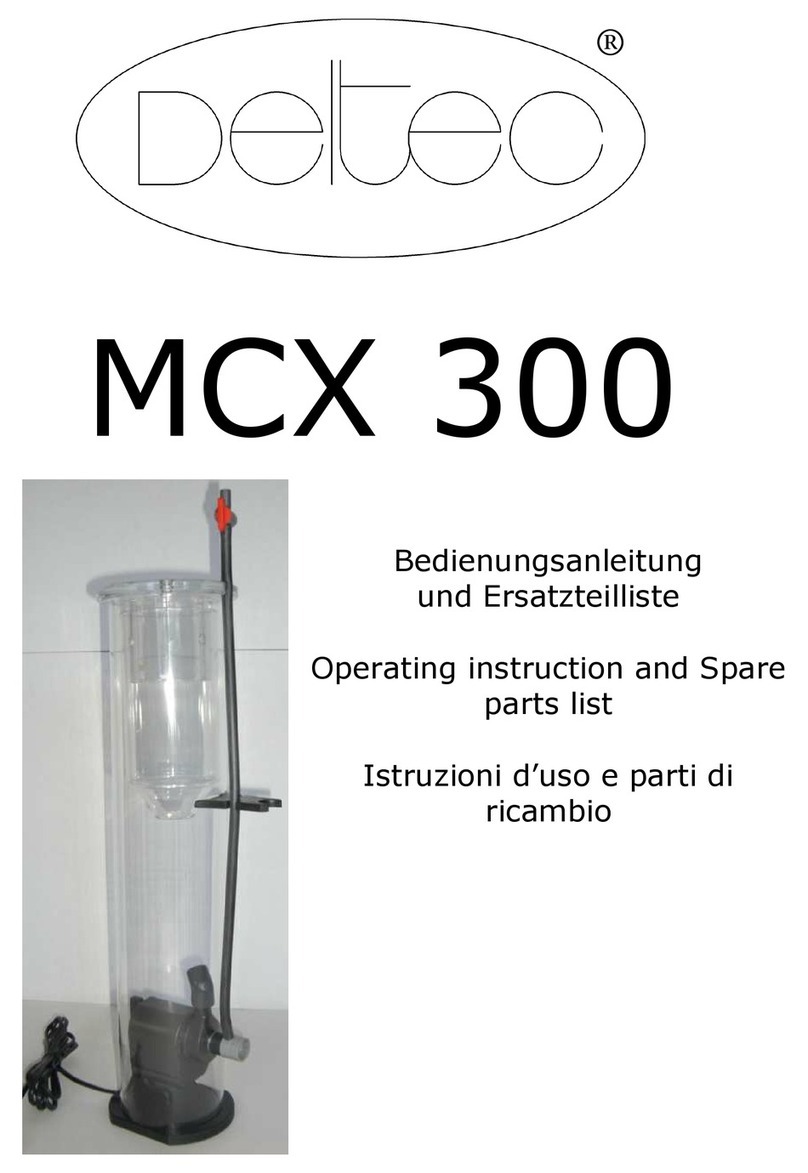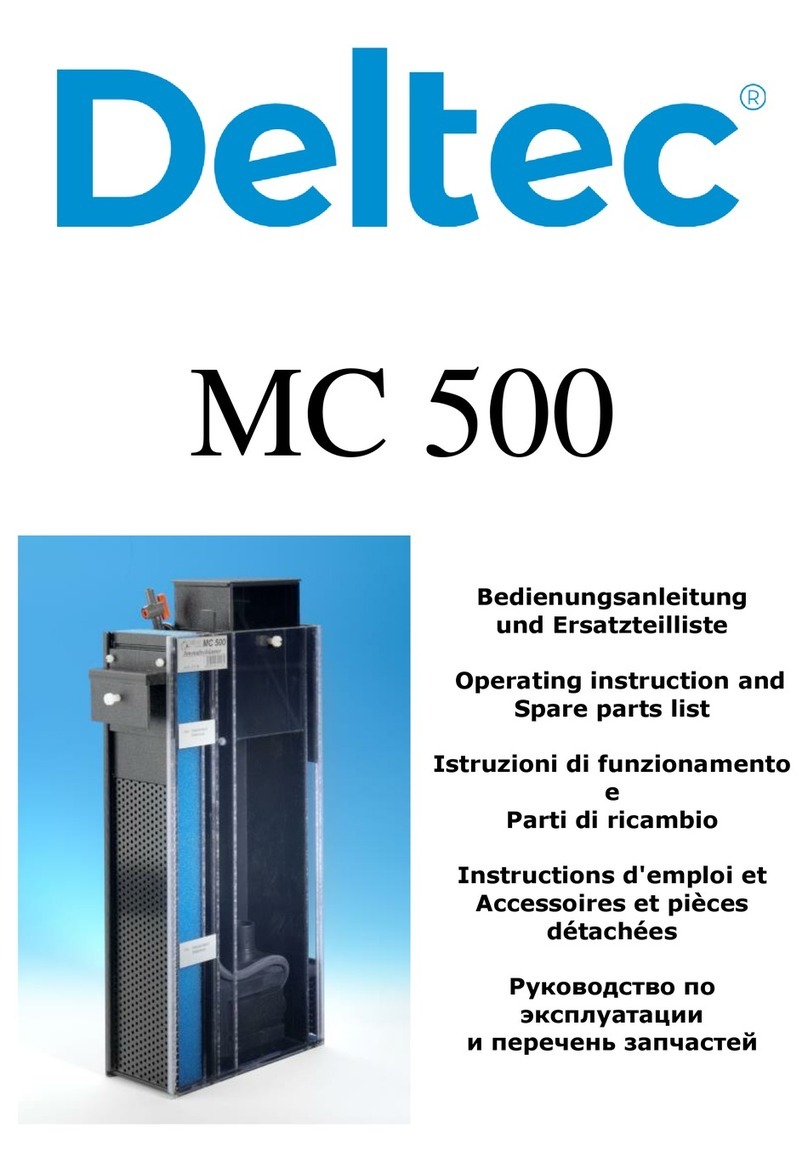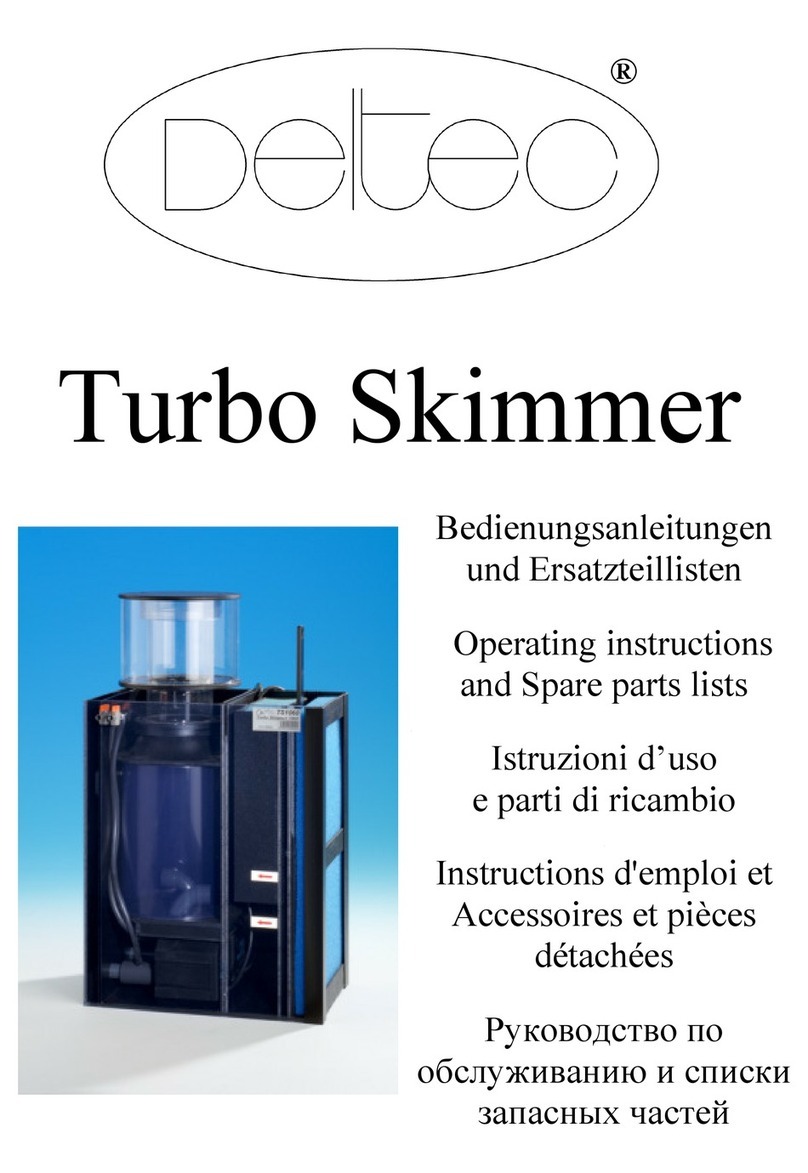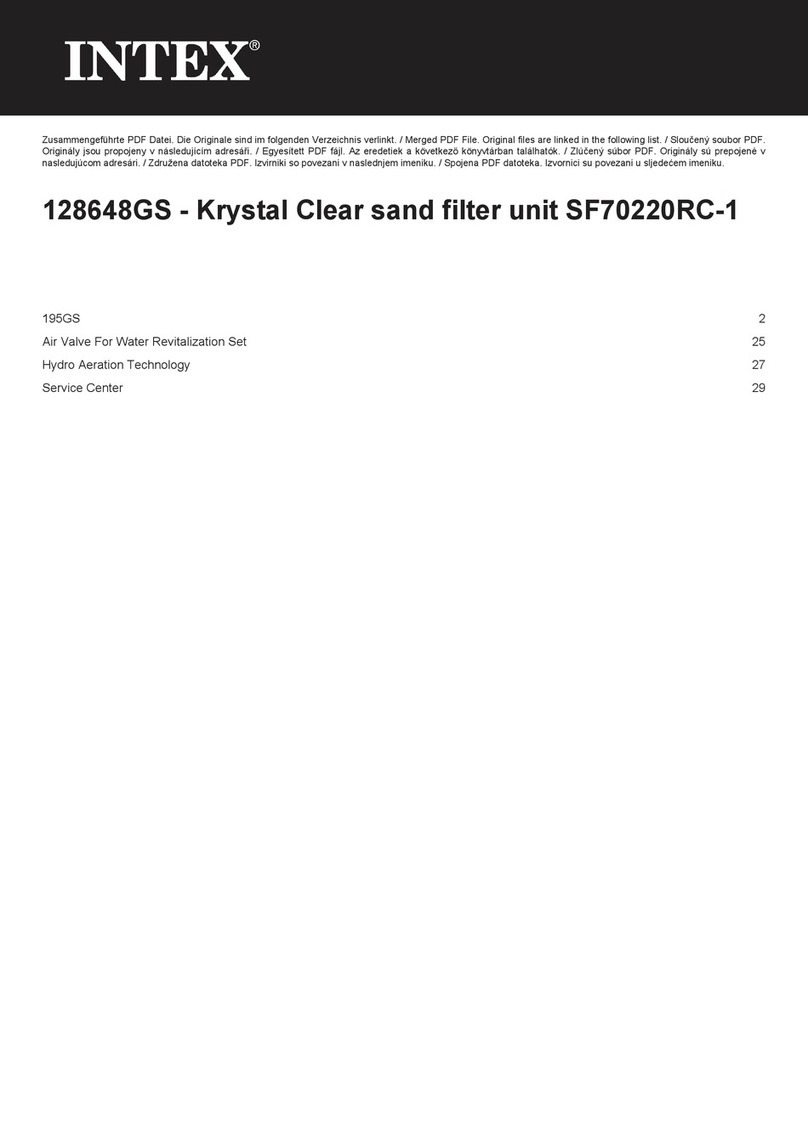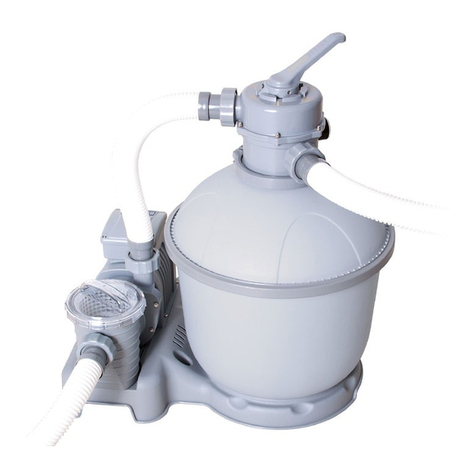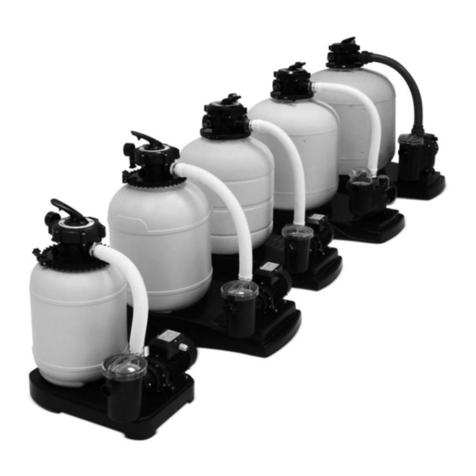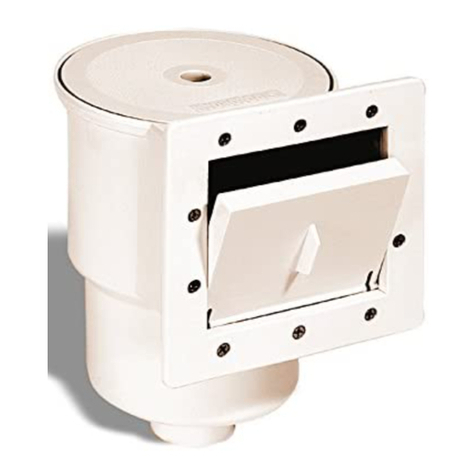Deltec TC 1655 User manual

®
TC 1655
Bedienungsanleitung Seite 2
Operating instruction
Page 9

DE
Wichtige Sicherheitshinweise
Warnung: Zum Schutz vor Verletzungen sollten grundlegende Vorsichtsmaßnahmen und folgende Sicherheitshinweise beachtet werden.
1) Sicherheitshinweise Lesen und befolgen
) Gefahr: Zur Vermeidung eines elektrischen Schlages sollten alle Aquarium Geräte mit Vorsicht gehandhabt werden. In keinem der unten aufgeführten Fälle sollte die
Reparatur vom Kunden versucht werden. Das Gerät muss zu einen autorisierten Kundendienst gebracht werden.
a. Wenn am Gerät ein abnormaler Wasseraustritt beobachtet wird, muss es sofort ausgesteckt werden.
b. Nach der Installation sollte das Gerät sorgfältig überprüft werden. Es darf nicht eingesteckt werden, wenn sich auf Teilen, die trocken bleiben müssen, Wasser befindet.
c. Ein Gerät mit beschädigtem Kabel oder Stecker darf nicht in Betrieb genommen werden. Das gleiche gilt, wenn das Gerät nicht richtig funktioniert, fallen gelassen oder
anderweitig beschädigt wurde.
d. Um ein Nasswerden des Gerätesteckers oder der Steckdose zu vermeiden, sollten der Aquarium
Unterschrank und das Becken seitlich von der Wandsteckdose aufgestellt werden. Somit können keine
Tropfen auf den Stecker oder die Steckdose fallen. Eine „Tropfenschleife“ (Bild) sollte in jedem Kabel
zwischen Aquarium und Wandsteckdose vorgesehen werden. Die „Tropfenschleife“ ist der Teil des
Kabels, der bei Verwendung eines Verlängerungskabels unter der Steckdose durchhängt (Bild). Auf
diese Weise tropft das Wasser unter der Steckdose vom Kabel ab und kann nicht mit dieser in
Berührung kommen. Wenn der Stecker oder die Steckdose nass wird, NICHT das Kabel herausziehen,
sondern die Stromversorgung an der Sicherung bzw. am Leistungsschalter trennen. Dann erst den
Stecker herausziehen und prüfen, ob sich Wasser in der Steckdose befindet.
3) Kinder müssen beaufsichtigt werden, wenn Sie sich am Aquarium oder in dessen nähe Aufhalten.
4) Zur Vermeidung von Verletzungen keine beweglichen oder heißen Teile, wie z.B. Heizungen, Reflektoren
, Glühbirnen usw. berühren.
5) Bei Nichtverwendung, vor dem Montieren/Demontieren von Teilen oder vor dem Reinigen müssen die
betroffenen Geräte stets ausgesteckt werden. Nicht am Kabel ziehen. Zum Herausziehen des Kabels immer den Stecker greifen.
6) Die Geräte dürfen nur für den vorgesehenen Zweck verwendet werden. Die Verwendung von Zubehör, das vom Hersteller nicht empfohlen oder verkauft wird, kann
gefährliche Bedingungen verursachen.
7) Das Gerät nicht an einer Stelle installieren oder lagern, wo es der Witterung oder Temperaturen unter null Grad ausgesetzt ist.
8) Vor der Inbetriebnahme eines an der Beckenwand montierten Gerätes muss sichergestellt werden, dass dieses richtig installiert und befestigt ist.
9) Alle Sicherheitshinweise auf dem Gerät müssen gelesen werden.
10) Wenn ein Verlängerungskabel notwendig ist, muss dieses die erforderliche Leistung haben. Ein Kabel, das für weniger Ampere oder Watt zugelassen ist, kann sich
überhitzen. Das Kabel ist so zu verlegen, dass niemand darüber stolpern oder daran hängen bleiben kann.
11) Das Gerät ist mit einem Schukostecker ausgestattet. Dieser Stecker darf auf keine Weise verändert oder umgangen werden.
Wird der Stecker entfernt erlischt jeder Garantieanspruch!
Diese Anleitung aufbewahren
- -

DE
Außenabschäumer TC 1655
Der Deltec Außenabschäumer TC 1655 (patentiert) ist ein kompakter Hochleistungsabschäumer. Die sehr hohe Abschäumerleistung
wird durch das einzigartige TC System in Kombination mit einer neuartigen extrem energieeffizienten Abschäumerpumpe erreicht.
Der Abschäumer wird u.a. mit einem Schaumtopfentleerungsschlauch, einem Schalldämpfer, der zum Reinigen zerlegt werden kann,
sowie einem Präzisions- Niveauregler geliefert.
Einbau
Der TC 1655 ist normalerweise für den Betrieb außerhalb der Filterwanne vorgesehen. Falls gewünscht und der Platz vorhanden ist,
kann er auch im Außenfilter eingesetzt werden. Für den Betrieb ist eine Wasserzufuhr erforderlich,
so z.B. durch:
-3-

DE

DE
Druckseite
Zur Erzielung optimaler Ergebnisse sollte die Pumpe für die Wasserversorgung etwas größer gewählt werden als der in den
Technischen Daten empfohlene maximale Wasserdurchfluss. Mit einem zwischen Pumpe und Abschäumer Einlauf geschalteten
Absperrhahn kann dann die optimale Durchflussmenge eingestellt werden (Zeichnung d). Der Durchmesser der Druckleitung sollte
nicht kleiner sein als von dem Abschäumerzufluss vorgegeben.
Ablaufleitung
Der Abschäumer muss so eingebaut werden, dass das ablaufende Wasser frei unter Schwerkraft in die Filterwanne zurücklaufen
kann. Niemals die Rücklaufleitung höher oder im Durchmesser kleiner als am Abschäumerausgang vorgegeben, verlegen. Die
Ablaufleitung sollte möglichst kurz gehalten werden. Wird der Abschäumer direkt am Aquarium betrieben, muss der Aufstellort so
gewählt werden, dass der Abschäumerablauf höher als die Aquariumoberkante ist (Zeichnung e). Zur Entperlung des ablaufenden
Wassers kann ein Entgasungsset geliefert werden.
d) Absperrhahn Zulauf e) Abschäumer direkt am Aquarium
Inbetriebnahme
Nach dem Einbau sollte der Abschäumer wie folgt in Betreib genommen werden:
-Niveauregler (Zeichnung f) durch drehen gegen den Uhrzeigersinn ganz öffnen.
-Wasserzufuhr einschalten.
-5-

DE
-Wasserstand im Abschäumer durch regeln der Durchflussmenge und langsamen schließen des Niveaureglers auf eine Höhe
innerhalb des Übergangrohres einstellen.
-Den Abschäumer genauestens auf eventuelle Beschädigungen und daraus resultierenden Leckstellen überprüfen.
-Abschäumerpumpe einschalten.
-Um ein anfängliches Überschäumen zur vermeiden, die Schaumsäule mittels des Niveaureglers zunächst eher niedriger
einstellen.
-Die Schaumbildung nach der Inbetriebnahme beobachten und eventuell mit dem Niveauregler korrigieren.
Eine endgültige Feineinstellung kann frühestens nach 4 Stunden vorgenommen werden. Dazu wird mit dem Niveauregler das
Schaumbild im Steigrohr so eingestellt, dass die feinen Luftblasen leicht über dem Schaumtopfboden anfangen zu größeren Blasen zu
zerplatzen (Zeichnung g).
-Für nassen Schaum (helle Flüssigkeit im Schaumtopf) den Niveauregler eindrehen.
-Für trockenen Schaum (dunkle Flüssigkeit im Schaumtopf) den Niveauregler herausdrehen.
f)Niveauregler g) Schaumtopf mit Übergangsrohr
-6-

DE
Betrieb mit Ozon
Der TC 1655 kann bis max. 50 mg/Std. Ozon betrieben werden. Dazu wird ein Anschluss des Ozongerätes (mit einem
Silikonschlauch) mit dem Luftschlauch der Abschäumerpumpe verbunden. Die Luft wird selbsttätig angesaugt. Bei Leistungsabfall
sollte das Ozongerät auf Verunreinigungen nachgesehen werden.
risches Meerwasser
Durch bestimmte Zusäte in vielen Meersalzen erzeugt der Abschäumer extrem feine Luftblasen, die nicht zurückgehalten werden
können, gleichzeitig wird sehr wässeriger Schaum erzeugt. Durch häufiges Entleeren des Schaumtopfes, können die besagten
Inhaltsstoffe im Aquariumwasser reduziert werden. Außerdem kann durch vorübergehendes stärkeres Füttern die extreme
Feinblasenbildung vermindert werden.
Wichtig
Die Pumpe niemals trocken laufen lassen.
Technische Daten
Maße
mm
Aquarium Größe
Liter
Wasserdurchfluss
Liter / Std.
Technische
Daten
Stellfläche
Stellfläche
mit
Verrohrung
Höhe
Höhe
Unterkante
Auslassrohr
normaler
Besatz
hoher
Besatz min. max.
TC 1655 90x190 37 x19 570 53 1 00 1000 1500
Stromaufnahme
Watt
Luftleistung
Liter / Std.
Anschlüsse Ø
mm
Technische
Daten
min. max. min. max. Zulauf Auslass
TC 1655 1 800 5 40
-7-

DE
ehlersuche
Symptom Ursache Maßnahme
Luftzuleitung zur Pumpe verstopft reinigen
Ozongerät verschmutzt reinigen
Luftschlauch abgeknickt Schlauchführung ändern
Pumpe läuft, jedoch
keine oder zu geringe
Luftmenge Strömungsklappe in Pumpe fest reinigen
Kommt bei bestimmten Seesalzen
und bei Zugabe von Wasser-
aufbereitungsmitteln vor
Andere Salze verwenden,
mehr füttern
Bei sehr starker Wasser-
Belastung
nach Neueinrichtung mit lebenden
Steinen
Luftmenge stark drosseln
Starke Luftperlung im
Ablaufwasser
Luftabsperrhahn zu stark
gedrosselt Lufthahn öffnen
Wartung
Bei korrektem Einbau und Einstellung benötigen Deltec Abschäumer denkbar wenig Wartung. Durch Kalkwassermischer und
Kalkreaktoren kann es jedoch zu Kalkablagerungen in der Pumpe kommen, die zu Funktionsstörungen führen können.
Es wird empfohlen bei Störungen oder alle 6 Monate den Rotor sowie die Strömungsklappe auf Leichtgängigkeit und die
Lufteinzugsdüse auf freien Durchgang hin zu prüfen. Durch eintauchen der Teile in einen handelsüblichen Entkalker lösen sich die
Kalkablagerungen. Ein frühzeitiges Verstopfen der Lufteinzugsdüse durch Luftstaub und Salzkristalle kann durch ca. 15-30 minütiges
Abstellen der Pumpe 1 mal pro Woche vermieden werden.
-8-

EN
IMPORTANT SA ETY INSTRUCTIONS
WARNING To guard against injury, basic safety precautions should be observed, including the following.
1)
READ AND FOLLOW ALL SAFETY INSTRUCTIONS.
)
DANGER – To avoid possible electric shock, special care should be taken since water is employed in the use of aquarium equipment. For each of the following situations,
do not attempt repairs by yourself; return the appliance to an authorized service facility for service or discard the appliance.
a)
If the appliance shows any sign of abnormal water leakage, immediately unplug it from the power source. (Immersible equipment only)
b)
Carefully examine the appliance after installation. It should not be plugged in if there is water on parts not interned to be wet.
c)
Do not operate any appliance if it has a damaged cord or plug, or if it is malfunctioning or has been dropped or damaged in any manner.
d)
To avoid the possibility of the appliance plug or receptacle getting wet, position aquarium stand and
tank to one side of a wall-mounted receptacle to prevent water from dripping onto the receptacle or
plug.
A “drip-loop”, shown in the figure below, should be arranged by the user for each cord connecting an
aquarium appliance to a receptacle. The “drip-loop” is that part of the cord below the level of the
receptacle, or the connector if an extension cord is used, to prevent water travelling along the cord and
coming in contact with the receptacle.
If the plug or socket does get wet, DON´T unplug the cord. Disconnect the fuse or circuit breaker that
supplies power to the appliance. Then unplug and examine for presence of water in the receptacle.
3)
Close supervision is necessary when any appliance is used by or near children.
4)
Always unplug an appliance from an outlet when not in use, before putting an or taking off parts, and
before cleaning. Never yank cord to pull plug from outlet. Grasp the plug and pull to disconnect.
5)
Do not use an appliance for other than intended use. The use of attachments not recommended or sold by the appliance manufacturer may cause an unsafe condition.
6)
Make sure an appliance mounted on a tank is securely installed before operating it.
7)
Read and observe all the important notices on the appliance.
8)
If an extension cord is necessary, a cord with a proper rating should be used. A cord rated for less amperes or watts than the appliance rating may overheat. Care should
bee taken to arrange the cord so that it will not be tripped over or pulled.
9)
This appliance has a polarized plug (one blade is wider than the other). As safety feature, this plug will fit in a polarized outlet only one way. If the plug does not fit,
contact a qualified electrician. Never use with an extension cord unless plug can be fully inserted. Do not attempt to defeat this safety feature.
Exception: This instruction may be omitted for an appliance that is not provided ith a polarized attachment plug.
Removing of the plug invalidates the warranty!
SAVE THESE INSTRUCTIONS
-9-

EN
Protein Skimmer TC 1655
Deltec TC 1655 protein skimmer is very compact, highly efficient and is fitted with a special low energy skimmer pump.
The TC 1655 skimmer feature
-precision water level adjuster
-remote skimmer cup drain
-silencer (the silencer can be opened for cleaning)
Installation
The TC 1655 protein skimmer is mainly used in combination with an external filter. He is normally fitted outside the filter sump; if
space permits he can be fitted also inside the sump. Please remember that the sump’s capacity to accept water when the main
aquarium pump is stopped, will be reduced.
-10-

EN

EN
eed line
In order to achieve best results it is important to fit a shut off cock into the water feed line. This allows exact regulation of the water
flow to compensate variations of existing salinity and water pollution. The diameter of the feed line should not be smaller than the
skimmer inlet. When choosing a pump to supply the skimmer, the capacity should be somewhat higher than the recommended
maximum flow through the skimmer (see technical data). The optimum flow through the skimmer can than be adjusted with the
shut-off valve in the feed line (Diagram d).
Outlet
The skimmer must be installed in such a way, that the cleaned water can flow unrestricted back into the sump (or aquarium). Never
fit an outlet pipe higher or smaller in diameter than existing on the skimmer. When installing the skimmer directly to the aquarium,
the skimmer outlet must be positioned higher than the top rim of the aquarium (Diagram e). A degassing set can be supplied to
reduce air bubbles entering the aquarium from the outlet pipe.
d) Shut off valve inlet e) Skimmer directly to the aquarium
-1 -

EN
Starting the skimmer
-open the water level adjuster (WAL) fully by turning it anti-clockwise (Diagram f)
-switch on water supply through skimmer
-adjust the water level inside the skimmer with the feed line shut-off cock and the WAL to somewhere between the top and
bottom of the skimmer neck, see (Diagram g)
-check the skimmer for possible damage and check the whole skimmer installation for leaks.
-switch on the skimmer pump
-to prevent initial over foaming and flooding of the skimmer cup, adjust the fine foam level in the cup’s riser tube to the bottom
plate of the skimmer cup. This is achieved by turning the WAL
-wait a minimum of 4 hours for the final adjustment. Turn the WAL so that the fine bubbles start bursting app. half way up the
cup’s riser tube.
-for dry foam turn the (WLA) anti clockwise, for wet foam clockwise.
-Important:
Never allow the pump to run dry.
f) Water level adjuster (WAL) g) Skimmer cup
-13-

EN
Operation with Ozone
The Skimmer can be operated with ozone up to max. 50 mg/h per pump. One air connection of the ozoniser should be connected via
a suitable silicon hose to the protein skimmer pump. The air is automatically sucked in the ozoniser by the skimmer pump. Should
the skimmer performance deteriorate please check the ozoniser for blockage.
resh salt water
If the skimmer is used with new water on an aquarium it is common for you to find an excessive quantity of small bubbles produced
and often the skimmer cup fills with a clear liquid. This is due to the high surface tension of the new water which prevents the
bubbles from bursting. Once the water matures this effect will do away but can take up to -3 weeks. The effect is different on
different salt brands and is often dependant on levels of conditioning agents added to the salt. Once these are skimmed out then the
skimmer will act normally.
Heavier feeding in the initial stages will give the chemically pure water something to react with and allow it to mature into proper
aquarium salt water rather than the initial chemical soup which is new salt water.
Technical Data
Dimensions
mm
Aquarium size
litre
Water flow rate
litre/h
technical
data
Footprint
Footprint
with Pipe
work
height
Height
under
outlet pipe
high
stocking
normal
stocking
min. max.
TC 1655 90x190 37 x19 570 53 1 00 1000 1500
Power consumption
Watt
Air
litre/h
Connections Ø
mm
technical
data
min. max. min. max. Feed line
Outlet
TC 1655 1 800 5 40
-14-

EN
ault finding
malfunction cause remedy
silencer, airline or venturi blocked
clean
airline kinked remove kink
ozonizer blocked clean
Pump produces
insufficient air
Pump flaps blocked clean
excessive air bubbles in
aquarium water
caused by additives in certain sea
salts and water conditions
use different salt or feed heavily
for a period, empty skimmer cup
frequently. This condition may
last for several weeks.
Pump does not start
Front bearing of the impeller stuck.
When the pump (after having been
used) has been stored dry for a period
of time, the front bearing can "dry out".
Remove impeller with the extractor tool
as illustrated and loosen the bearing by
moving the bearing plate around and
along the ceramic shaft in tap water.
Maintenance
The Deltec skimmer range should need very little adjustment and maintenance once set correctly however due to the high levels of
calcium in marine aquariums it is common for deposits to build up on moving parts requiring periodical cleaning. Deltec pumps are
fitted with little flaps inside the outlet of the pump and inside the housing, which flip from one side to the other depending on the
direction of rotation thus ensuring that the pump always operates at full duty. It is recommended every 6 months, or when required,
that the pumps are removed from the skimmer having first drained the body of Water.
Check and clean the impellor of debris. Ensure that the direction flaps move easily and if necessary soak the neck of the pump
housing in white vinegar or lime scale remover to dissolve any calcium carbonate deposits. A build up of calcium, dust and salt can
restrict or block the venturi inlet on the connecting pipe work and reduce the skimming efficiency. This should be checked and
carefully cleaned with a toothpick or fine drill rotated between the fingertips.
It is advisable to stop the pump for approximately 15 minutes once every week in order to dissolve any dust or salt crystals that may
have collected in the venture tube.
-15-

NORME DI SICUREZZA
AVVERTENZA: Per evitare incidenti si raccomanda di osservare le norme generali di sicurezza, tra cui le seguenti:
1) LEGGERE E SEGUIRE SCRUPOLOSAMENTE TUTTE LE NORME DI SICUREZZA.
) PERICOLO – Considerato che l’uso di attrezzature per acquario avviene in presenza di acqua, agire sempre con particolare cautela per evitare scosse elettriche. Per
ognuna delle seguenti situazioni possibili, si raccomanda di non tentare di eseguire da sé eventuali riparazioni, ma di portare l’apparecchio presso un centro assistenza
autorizzato o provvedere alla sua rottamazione.
a. (Solo per apparecchi ad immersione). Se l’apparecchio mostra perdite d’acqua anormali, scollegarlo immediatamente dall’alimentazione.
b. Dopo avere installato l’apparecchio, eseguire un controllo accurato. Non collegare l’apparecchio all’alimentazione nel caso si osservi la presenza di acqua in parti non
destinate ad essere bagnate.
c. Non mettere in funzione l’apparecchio se il cavo d’alimentazione o la spina appaiono danneggiati, se l’apparecchio è malfunzionante, se è caduto o ha subito un
qualsiasi danno.
d. Per evitare il gocciolamento dell’acqua sulla presa o sulla spina, posizionare l’acquario e il mobile di
fianco alla presa montata a parete in modo che questa resti visibile.
Si raccomanda di fare eseguire al cavo una curva “anti-gocciolamento” come mostrato nella figura
sottostante. Eseguire l’operazione per tutti i componenti elettrici dell’acquario. In questo modo una
parte di cavo si trova sotto il livello della presa, o della spina di collegamento nel caso si usi una
prolunga, impedendo così che l’acqua gocciolando lungo il cavo venga a contatto con la presa.
Se la presa o la spina si bagna, NON disinserire il cavo, ma scollegare l’interruttore generale che porta
corrente all’apparecchio. Quindi scollegare la spina e verificare la presenza di acqua all’interno della
presa.
3) Se l’apparecchio viene utilizzato da o in presenza di bambini, è necessaria un’attenta supervisione da
parte degli adulti.
4) Scollegare sempre il cavo d’alimentazione quando l’apparecchio è inutilizzato, prima di aggiungere o prelevare delle parti e prima di effettuare la pulizia. Per scollegare il
cavo d’alimentazione, afferrare bene la spina ed estrarla dalla presa senza tirare mai direttamente il cavo.
5) Non utilizzare l’apparecchio per usi diversi da quelli a cui è destinato. L’uso di accessori non raccomandati o non venduti dal produttore dell’apparecchio possono essere
causa di condizioni di funzionamento non sicure.
6) Assicurarsi che gli apparecchi montati sull’acquario siano correttamente installati prima di avviarli.
7) Leggere ed osservare tutte le informazioni importanti sull’apparecchio.
8) Se è necessario l’uso di una prolunga, assicurarsi che il cavo sia adatto al voltaggio utilizzato. Se il cavo è messo a punto per meno ampere or watt rispetto
all’apparecchio, potrebbe surriscaldarsi. Fare attenzione che il cavo non sia troppo teso o schiacciato.
9) (Solo per UK) Questo apparecchio è dotato di spina polarizzata (uno spinotto è più largo dell’altro). Come misura di sicurezza, tale spina potrà essere inserita in un solo
modo in una presa polarizzata. Se la spina non è adatta, rivolgersi ad un elettricista qualificato. Non utilizzare una prolunga se la spina non si inserisce completamente.
Non tentare di eludere questa condizione di sicurezza.
Eccezione: Questa avvertenza può essere omessa se l’apparecchio non è dotato di spina polarizzata.
In caso di manomissione della spina decade ogni garanzia!
“CONSERVATE LE PRESENTI ISTRUZIONI”
-16-

Instructions de sécurité importantes
Avertissement : Pour protéger contre quelconques blessures, il faut respecter les mesures de prudence et les instructions de sécurité suivantes :
1) Lire et respecter les instructions de sécurité.
) Danger : Pour éviter une électrocution, il faut manipuler tous les appareils de l'aquarium avec prudence. Dans aucun des cas indiqué plus bas, le client ne devrait pas
essayer de procéder à une réparation. L’appareil doit être délivré au service après-vente autorisé.
a) Si vous observez une fuite d'eau anormale sur l'appareil, il faut retirer immédiatement la prise de l’appareil.
b) Après l'installation, il faut vérifier soigneusement l'appareil. Il ne faut pas enficher sa prise quand de l'eau se trouve sur des pièces qui doivent rester sèches.
c) Un appareil muni d’un câble ou d’une fiche détériorés ne doit pas être mis en service. Ceci est aussi valable quand l’appareil ne fonctionne pas correctement, est tombé
par terre ou a été détérioré d’une autre manière.
d) Pour éviter que la fiche de l'appareil ou la prise de courant se mouille, il faut placer le meuble de l’aquarium
et le bassin à côté de la prise de courant murale. Ainsi aucune goutte d'eau ne tombera sur la fiche ou la
prise de courant. Une « boucle d’égouttage » devrait être prévue entre l'aquarium et la prise de courant
murale. La « boucle d’égouttage » est la partie du câble qui fléchit sous la prise de courant en cas d’emploi
d’une rallonge. De cette manière, l'eau s'égouttera sous la prise de courant du câble et ne pourra pas entrer
en contact avec celui-ci. Si la fiche ou la prise de courant se mouille, NE PAS retirer le câble mais couper
l’alimentation en courant au fusible ou au sectionneur de puissance. Ne retirer la fiche qu’après avoir ceci et
vérifier si de l'eau se trouve dans la prise de courant.
3) Les enfants doivent être surveillés quand vous vous occupez de l'aquarium ou vous vous trouvez à
proximité.
4) Pour éviter quelconques blessures, ne pas toucher les pièces mobiles ou chaudes, telles que les chauffages,
les réflecteurs, les ampoules etc.
5) Les fiche des appareils qui ne sont pas utilisés, avant le montage/démontage de pièces de ces appareils ou
avant leur nettoyage, doivent être retirées. Ne pas tirer au câble. Pour sortir le câble, toujours saisir la fiche.
6) Les appareils ne doivent être utilisés qu'aux fins prévues. L’emploi d’accessoires que le fabricant n'a pas recommandés ou vendus, peut causer des conditions
dangereuses.
7) Ne pas installer ou entreposer l’appareil à un endroit où il est exposé aux intempéries ou à des températures en dessous de zéro.
8) Avant la mise en service d’un appareil monté à la paroi du bassin, il faut garantir que cet appareil est correctement installé et fixé.
9) Toutes les indications de sécurité sur l'appareil doivent être lues.
10) S'il faut utiliser une rallonge, elle doit avoir la puissance nécessaire. Un câble qui est homologué pour peu d’ampères ou de watts, peut se surchauffer. Le câble doit être
posé de sorte que personne ne trébuche dessus ou y reste accroché.
11) L’appareil est équipé d’une fiche à contact de protection. Cette fiche ne doit en aucun cas être modifiée ou contournée.
Si la fiche est retirée, tout droit à garantie sera annulé !
Conserver ces instructions
-17-

Ersatzteilliste / Spare parts list
-18-

Nr.
Art. Nr. Bezeichnung Description
A 28105000
Pumpe mit Verrohrung Pump with piping
1 80161000
Grundger t Body only
2 80162000
Siebplatte Strainer
3 80163000
Schaumtopf Skimmer cup
4 80164000
Schaumtopf Deckel Skimmer cup lid
5 80500100
O-Ring Schaumtopf O-ring Skimmer cup
6 80010000
Stator Stator
7 80014000
Rotor Needle wheel
8 25803000
O-Ring Pumpe O-Ring pump
9 80209000
Verrohrung Piping
10
93042400
O-Ring 25 O-Ring 25
11
27096000
Lager Bearing
12
80169000
Adapter Adapter
13
80205000
Schalld mpfer1 Silencer 1
14
80206000
Schalld mpfer 2 Silencer 2
15
61770000
Silikonschlauch 1 Meter Silicone hose 1 meter
16
80167000
Niveauregler Wather level adjuster
17
93042400
O-Ring 25 O-Ring 25
18
93042200
Einlegeteil 25 Collar 25
19
93042100
Überwurfmutter 25 Cap nut 25
20
93419000
Kugelhahn Shutt-off-valve
21
80168000
Rücklauf Outlet pipe
22
93044400
O-Ring 40 O-Ring 40
-19-

Deltec GmbH
Steller Straße 75
D-27755 Delmenhorst
Deutschland / Germany
www.deltec-aquaristic.com
Deltec GmbH 20
Table of contents
Languages:
Other Deltec Swimming Pool Filter manuals
Popular Swimming Pool Filter manuals by other brands

LASWIM
LASWIM EC Series Installation and user manual
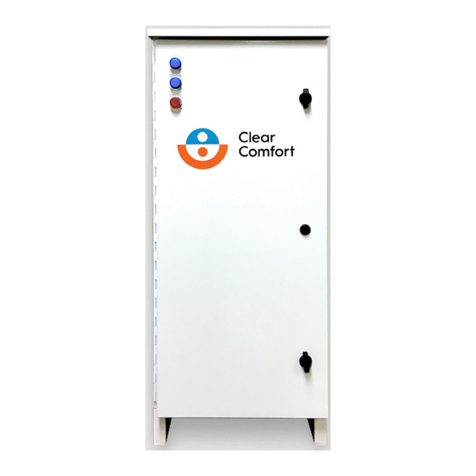
Clear Comfort
Clear Comfort CCW300 quick guide

Summer Fun
Summer Fun SF-130 Installation and maintenance manual
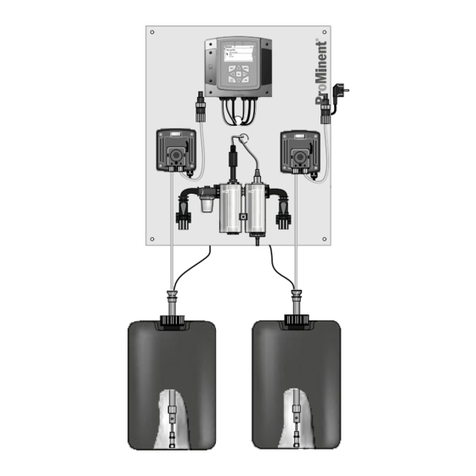
ProMinent
ProMinent DULCODOS Pool Soft Assembly and operating instructions
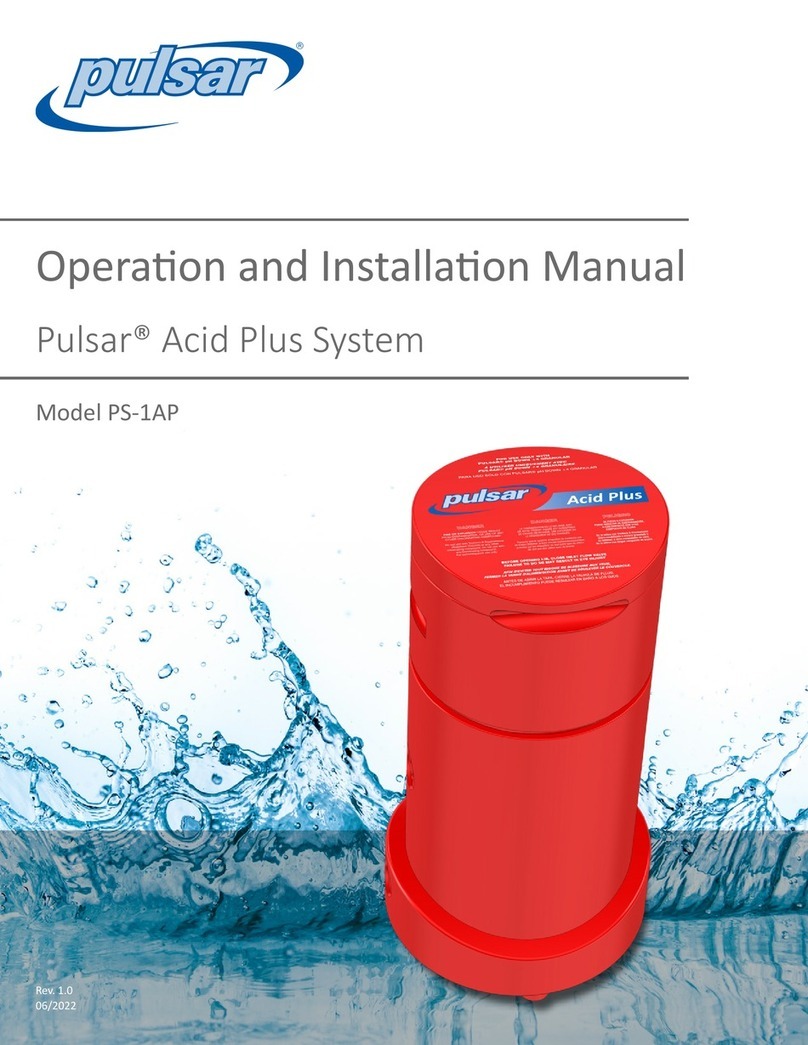
Innovative Water Care
Innovative Water Care Pulsar Acid Plus System Operation and installation manual

PoolRite
PoolRite Xtreme Chlorinator manual

Bestway
Bestway InflateYourFun 58233 manual

Hayward
Hayward Ntech Evac-sharkvac owner's manual
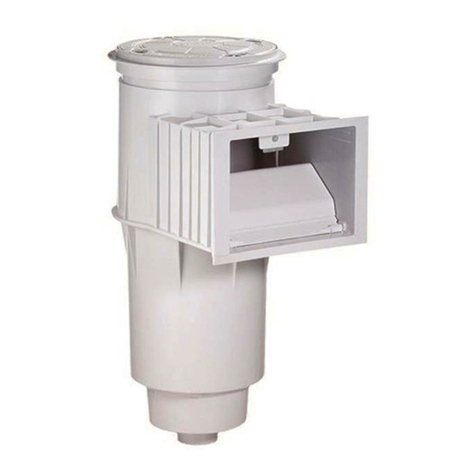
Pentair
Pentair ADMIRAL S-15 installation guide

Quick Salt
Quick Salt e-360 user manual

Pentair Pool Products
Pentair Pool Products ClearPro Technology TR 40 Installation & user guide
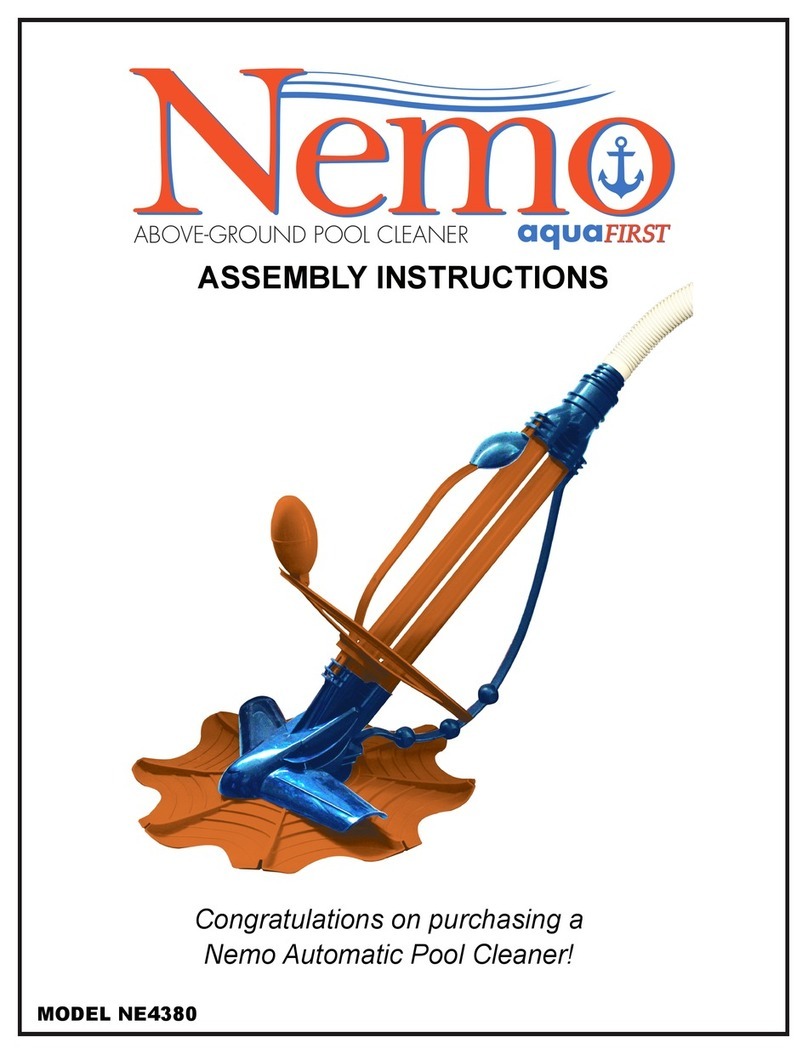
Nemo
Nemo NE4380 Assembly instructions

